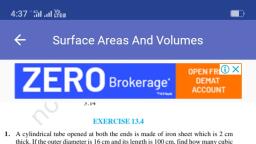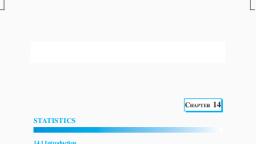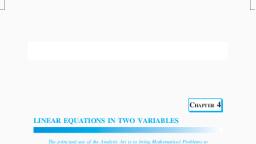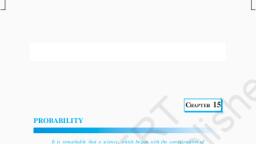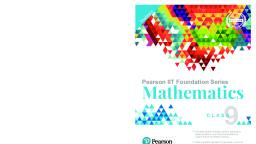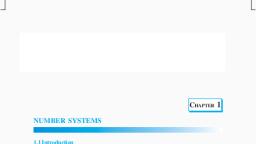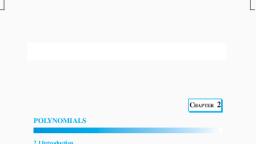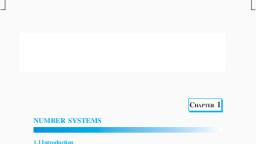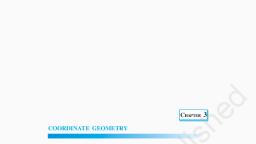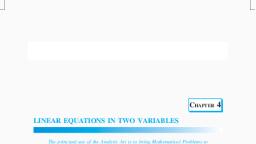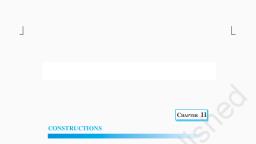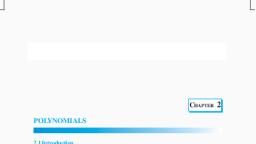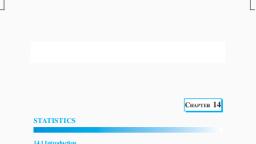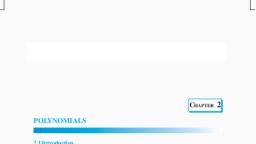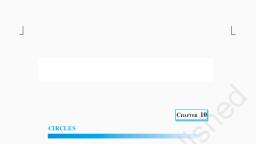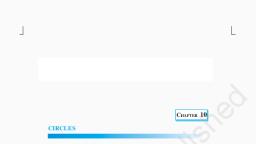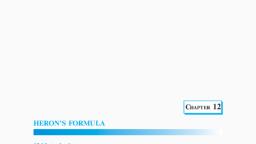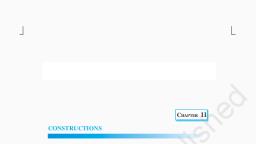Page 1 :
ANSWERS/HINTS, , 325, , APPENDIX 1, ANSWERS/ HINTS, EXERCISE 1.1, 1. Yes. 0 =, , 0 0 0, = = etc., denominator q can also be taken as negative integer., 1 2 3, , 2. There can be infinitely many rationals betwen numbers 3 and 4, one way is to take them, 3=, , 3., , 21, 28 ., 22 23 24 25 26 27 ., ,4=, ,, ,, ,, ,, ,, Then the six numbers are, 6 +1, 6+1, 7 7 7 7 7 7, , 31 32 33 34 35, 3 30 4 40 ., ,, ,, ,, ,, ⋅, , =, =, Therefore, five rationals are :, 50 50 50 50 50, 5 50 5 50, , 4. (i), , True, since the collection of whole numbers contains all the natural numbers., , (ii) False, for example – 2 is not a whole number., (iii) False, for example, , 1, is a rational number but not a whole number., 2, , EXERCISE 1.2, 1. (i), , True, since collection of real numbers is made up of rational and irrational numbers., , (ii) False, no negative number can be the square root of any natural number., (iii) False, for example 2 is real but not irrational., 2. No. For example,, , 4 = 2 is a rational number., , 3. Repeat the procedure as in Fig. 1.8 several times. First obtain, , File Name : C:\Computer Station\Maths-IX\Chapter\Answers (16–12–2005).PM65, , 4 and then, , 5.
Page 2 :
326, , MATHEMATICS, , EXERCISE 1.3, 1. (i), , 2., , 0.36, terminating., , (ii) 0.09 , non-terminating repeating., , (iii) 4.125, terminating., , (iv) 0.230769 , non-terminating repeating., , (v) 0.18 non-terminating repeating., , (vi) 0.8225 terminating., , 2, 1, = 2 × = 0.285714,, 7, 7, 5, 1, = 5 × = 0.714285,, 7, 7, , 3. (i), , (ii), , 3, 1, = 3 × = 0.428571,, 7, 7, 6, 1, = 6 × = 0.857142, 7, 7, , 2, [Let x = 0.666. . . So 10x = 6.666. . . or, 10x = 6 + x, 3, 43, 90, , 4, 1, = 4 × = 0.571428,, 7, 7, , (iii), , 4. 1 [Let x = 0.9999. . . So 10 x = 9.999. . ., , or , x =, , 6 2, = ], 9 3, , 1, 999, , or, 10 x = 9 + x or, x = 1], , 5. 0.0588235294117647, 6. The prime factorisation of q has only powers of 2 or powers of 5 or both., 7. 0.01001000100001. . ., 0.202002000200002. . ., 0.003000300003. . ., 8. 0.75075007500075000075. . ., 0.767076700767000767. . ., 0.808008000800008. . ., 9. (i), (iv) and (v) irrational; (ii) and (iii) rational., , EXERCISE 1.4, 1. Proceed as in Section 1.4 for 2.665., 2. Proceed as in Example 11., , EXERCISE 1.5, 1. (i), , Irrational, , (ii) Rational, , (iii) Rational, , (iv) Irrational, , (v) Irrational, 2. (i), , 6+3 2 +2 3+ 6, , (ii) 6, , (iii) 7 + 2 10, , (iv) 3, , 3. There is no contradiction. Remember that when you measure a length with a scale or any, other device, you only get an approximate rational value. So, you may not realise that, either c or d is irrational., , File Name : C:\Computer Station\Maths-IX\Chapter\Answers (16–12–2005).PM65
Page 3 :
ANSWERS/HINTS, , 327, , 4. Refer Fig. 1.17., 7, 7, , 5. (i), , (ii), , 7+ 6, , (iii), , 5− 2, 3, , 7 +2, 3, , (iv), , EXERCISE 1.6, 1. (i), , 8 (ii) 2 (iii) 5, , 3. (i), , 215, , 1, 2. (i) 27 (ii) 4 (iii) 8 (iv) 5, 1, , 1, , (iii) 114, , (iv) 56 2, , 13, , (ii) 3–21, , 1, 1, −, ⎡, ⎤, 3 − 3, 3, (125), 5, =, ( ) = 5–1 ⎥, ⎢, ⎣, ⎦, , EXERCISE 2.1, 1. (i) and (ii) are polynomials in one variable, (v) is a polynomial in three variables,, (iii), (iv) are not polynomials, because in each of these exponent of the variable is not a, whole number., 2. (i), , 1, , (ii) –1, , 3. 3x35 – 4;, , (iii), , π, 2, , (iv) 0, , 2 y100 (You can write some more polynomials with different coefficients.), , 4. (i), , 3, , (ii) 2, , (iii) 1, , (iv) 0, , 5. (i), , quadratic, , (ii) cubic, , (iii) quadratic, , (iv) linear, , (v) linear, , (vi) quadratic, , (vii) cubic, , EXERCISE 2.2, 1. (i), , 3, , (ii) –6, , (iii) –3, , 2. (i), , 1, 1, 3, , (ii) 2, 4, 4, , (iii) 0, 1, 8, , (iv) –1, 0, 3, , 3. (i), , Yes, , (ii) No, , (iii) Yes, , (iv) Yes, , (v) Yes, , (vi) Yes, , (vii) −, 4. (i), , –5, , (v) 0, , 1, 3, , is a zero, but, , 2, 3, , (ii) 5, (vi) 0, , is not a zero of the polynomial, , −5, 2, d, (vii) −, c, (iii), , File Name : C:\Computer Station\Maths-IX\Chapter\Answers (16–12–2005).PM65, , (viii) No, (iv), , 2, 3
Page 5 :
ANSWERS/HINTS, , (iii), , 329, , 27 3 27 2 9, x +, x + x +1, 8, 4, 2, , 7. (i), , 970299, , 8. (i), , (2a + b)(2a + b)(2a + b), , 3, (iv) x −, , (ii) 1061208, , 8 3, 4 xy 2, y − 2 x2 y +, 27, 3, , (iii) 994011992, (ii) (2a – b)(2a – b)(2a – b), , (iii) (3 – 5a)(3 – 5a)(3 – 5a), , (iv) (4a – 3b)(4a – 3b)(4a – 3b), , 1 ⎞⎛, 1 ⎞⎛, 1⎞, ⎛, (v) ⎜ 3 p − ⎟ ⎜ 3 p − ⎟ ⎜ 3 p − ⎟, 6 ⎠⎝, 6 ⎠⎝, 6⎠, ⎝, 10. (i) (3y + 5z) (9y2 + 25z2 – 15yz), , (ii) (4m – 7n) (16m2 + 49n2 + 28mn), , 11. (3x + y + z) (9x2 + y2 + z2 – 3xy – yz – 3xz), 12. Simiplify RHS., 13. Put x + y + z = 0 in Identity VIII., 14. (i), , –1260. Let a = –12, b = 7, c = 5. Here a + b + c = 0. Use the result given in Q13., , (ii) –16380, 15. (i), , One possible answer is : Length = 5a – 3, Breadth = 5a – 4, , (ii) One possible answer is : Length = 7y – 3, Breadth = 5y + 4, 16. (i), , One possible answer is : 3, x and x – 4., , (ii) One possible answer is : 4k, 3y + 5 and y – 1., , EXERCISE 3.1, 1. Consider the lamp as a point and table as a plane., Choose any two perpendicular edges of the table., Measure the distance of the lamp from the longer, edge, suppose it is 25 cm. Again, measure the, distance of the lamp from the shorter edge, and, suppose it is 30 cm. You can write the position of the, lamp as (30, 25) or (25, 30), depending on the order, you fix., , File Name : C:\Computer Station\Maths-IX\Chapter\Answers (16–12–2005).PM65, , 25 cm, , Lamp, 30 cm
Page 6 :
330, , MATHEMATICS, , N, , Street 3, Street 4, Street 5, , Street 1, Street 2, , 2. The Street plan is shown in figure given below., , Street 1, Street 2, (4, 3), , W, , C, , (3, 4), , Street 3, E, Street 4, Street 5, , S, Both the cross-streets are marked in the figure above. They are uniquely found because, of the two reference lines we have used for locating them., , EXERCISE 3.2, 1. (i) The x - axis and the y - axis, , (ii) Quadrants (iii) The origin, , 2. (i) (– 5, 2) (ii) (5, –5) (iii) E (iv) G, , (v) 6 (vi) – 3 (vii) (0, 5) (viii) (–3, 0), , EXERCISE 3.3, 1. The point (–2, 4) lies in, quadrant II, the point (3, –1), lies in the quadrant IV, the point, (– 1, 0) lies on the negative, x - axis, the point (1, 2) lies in, the quadrant I and the point, (–3, –5) lies in the quadrant III., Locations of the points are, shown in the adjoining figure., , Y, 5, 4, 3, 2, (–1, 0) 1, , (–2, 4), , X´, , (1, 2), , –5 –4 –3 –2 –1 O, –1, –2, –3, –4, (–3, –5), –5, Y´, , File Name : C:\Computer Station\Maths-IX\Chapter\Answers (16–12–2005).PM65, , 1 2 3 4 5, (3, –1), , X
Page 7 :
ANSWERS/HINTS, , 331, , Y, , 2. Positions of the points are shown, by dots in the adjoining figure., , (–2, 8), (–1, 7), , 8, 7, 6, 5, 4, 3, , (1, 3), , 2, 1, X´, , –4 –3 –2 –1 O, 1 2, –1 (0, -1.25), –2, , 3, , 4 5, (3, –1), , Y´, , EXERCISE 4.1, 1. x – 2y = 0, 2. (i), , 2x + 3y – 9.35 = 0; a = 2, b = 3, c = – 9.35, , (ii) x –, , y, −1 ,, – 10 = 0; a = 1, b =, c = –10, 5, 5, , (iii) –2x + 3y – 6 = 0; a = –2, b = 3, c = –6, (iv) 1.x – 3y + 0 = 0; a = 1, b = –3, c = 0, (v) 2x + 5y + 0 = 0; a = 2, b = 5, c = 0, (vi) 3x + 0.y + 2 = 0; a = 3, b = 0, c = 2, (vii) 0.x + 1.y – 2 = 0; a = 0, b = 1, c = –2, (viii) –2x + 0.y + 5 = 0; a = –2, b = 0, c = 5, , EXERCISE 4.2, 1. (iii), because for every value of x, there is a corresponding value of y and vice-versa., , File Name : C:\Computer Station\Maths-IX\Chapter\Answers (16–12–2005).PM65, , X
Page 8 :
332, , MATHEMATICS, , 2. (i) (0, 7), (1, 5), (2, 3), (4, –1), , ⎛9 ⎞, (ii) (1, 9 – π), (0, 9), (–1, 9 + π), ⎜ , 0 ⎟, ⎝π ⎠, ⎛ 1⎞, (iii) (0, 0), (4, 1), (– 4, 1), ⎜ 2, ⎟, ⎝ 2⎠, 3. (i), , No, , (ii) No, , (iii) Yes, , (iv) No, , (v) No, , 4. 7, , EXERCISE 4.3, 1. (i), , (ii), , x, , –2, , (iii), , (iv), , File Name : C:\Computer Station\Maths-IX\Chapter\Answers (16–12–2005).PM65
Page 9 :
ANSWERS/HINTS, , 333, , 2. 7x – y = 0 and x + y = 16; infintely many [Through a, point infinitely many lines can be drawn], 3., , 5, 3, , 5x – y + 3 = 0, , 4. 5x – y + 3 = 0, , (0, 3), , 5. For Fig. 4.6, x + y = 0 and for Fig. 4.7, y = –x + 2., , ( – 3 , 0), 5, , 6. Supposing x is the distance and y is the work done., Therefore according to the problem the equation will, be y = 5x., (i) 10 units, , (ii) 0 unit, , Y, , y = 5x, , (1, 5), , X´, , X, , O, , (–1, –5), Y´, 7. x + y = 100, , x+, y=, 0, 10, , (100, 0), , File Name : C:\Computer Station\Maths-IX\Chapter\Answers (16–12–2005).PM65
Page 10 :
334, , MATHEMATICS, , 8. (i), , See adjacent figure., , (ii) 86º F, , =, , (iii) 35° C, (iv) 32° F, –17.8° C (approximately), (v) Yes, – 40° (both in F and C), , –, , –, , EXERCISE 4.4, 1. (i), , y=3, , (ii), , y=3, , File Name : C:\Computer Station\Maths-IX\Chapter\Answers (16–12–2005).PM65
Page 11 :
ANSWERS/HINTS, , 335, , 2. (i), , (ii), , EXERCISE 5.1, 1., , (i) False. This can be seen visually by the student., (ii) False. This contradicts Axiom 5.1., (iii) True. (Postulate 2), (iv) True. If you superimpose the region bounded by one circle on the other, then they, coincide. So, their centres and boundaries coincide. Therefore, their radii will, coincide., (v) True. The first axiom of Euclid., , 3., , There are several undefined terms which the student should list. They are consistent,, because they deal with two different situations — (i) says that given two points A and, B, there is a point C lying on the line in between them; (ii) says that given A and B, you, can take C not lying on the line through A and B., These ‘postulates’ do not follow from Euclid’s postulates. However, they follow from, Axiom 5.1., , 4., , AC = BC, So,, , AC + AC = BC + AC, , (Equals are added to equals), , i.e.,, , 2AC = AB, , (BC + AC coincides with AB), , Therefore,, , AC =, , 1, AB, 2, , File Name : C:\Computer Station\Maths-IX\Chapter\Answers (16–12–2005).PM65
Page 12 :
336, , MATHEMATICS, 5., , Make a temporary assumption that different points C and D are two mid-points of AB., Now, you show that points C and D are not two different points., , 6., , AC = BD, , (Given) (1), , AC = AB + BC, , (Point B lies between A and C), , (2), , BD = BC + CD, , (Point C lies between B and D) (3), , Substituting (2) and (3) in (1), you get, AB + BC = BC + CD, So,, 7., , AB = CD, , (Subtracting equals from equals), , Since this is true for any thing in any part of the world, this is a universal truth., , EXERCISE 5.2, 1., , Any formulation the student gives should be discussed in the class for its validity., , 2., , If a straight line l falls on two straight lines m and n such that sum of the interior angles, on one side of l is two right angles, then by Euclid’s fifth postulate the line will not meet, on this side of l. Next, you know that the sum of the interior angles on the other side of, line l will also be two right angles. Therefore, they will not meet on the other side also., So, the lines m and n never meet and are, therefore, parallel., , EXERCISE 6.1, 1., , 30°, 250°, , 2. 126°, , 4. Sum of all the angles at a point = 360°, , 5., , ∠ QOS = ∠ SOR + ∠ ROQ and ∠ POS = ∠ POR – ∠ SOR., , 6. 122°, 302°, , EXERCISE 6.2, 1., , 130°, 130°, , 2. 126°, , 3. 126°, 36°, 54°, , 4. 60°, , 5. 50°, 77°, , 6., , Angle of incidence = Angle of reflection. At point B, draw BE ⊥ PQ and at point C,, draw CF ⊥ RS., , EXERCISE 6.3, 1., , 65°, , 2. 32°, 121°, , 3. 92°, , 6., , Sum of the angles of ∆ PQR = Sum of the angles of ∆ QTR and, ∠ PRS = ∠ QPR + ∠ PQR., , EXERCISE 7.1, 1., , They are equal., , 6. ∠ BAC = ∠ DAE, , File Name : C:\Computer Station\Maths-IX\Chapter\Answers (16–12–2005).PM65, , 4. 60°, , 5. 37°, 53°
Page 13 :
ANSWERS/HINTS, , 337, , EXERCISE 7.2, 6. ∠ BCD =∠ BCA + ∠ DCA = ∠ B + ∠ D, , 7. each is of 45°, , EXERCISE 7.3, 3., , (ii) From (i), ∠ ABM = ∠ PQN, , EXERCISE 7.4, 4., , Join BD and show ∠ B > ∠ D. Join AC and show ∠ A > ∠ C., , 5., , ∠ Q + ∠ QPS > ∠ R + ∠ RPS, etc., , EXERCISE 8.1, 1., , 36°, 60°, 108° and 156°., , 6., , (i) From ∆ DAC and ∆ BCA, show ∠ DAC = ∠ BCA and ∠ ACD = ∠ CAB, etc., (ii) Show ∠ BAC = ∠ BCA, using Theorem 8.4., , EXERCISE 8.2, 2., , Show PQRS is a parallelogram. Also show PQ || AC and PS || BD. So, ∠ P = 90°., , 5., , AECF is a parallelogram. So, AF || CE, etc., , EXERCISE 9.1, 1., , (i) Base DC, parallels DC and AB;, , (iii) Base QR, parallels QR and PS;, , (v) Base AD, parallels AD and BQ, , EXERCISE 9.2, 1., , 12.8 cm., , 2. Join EG; Use result of Example 2., , 6., , Wheat in ∆ APQ and pulses in other two triangles or pulses in ∆ APQ and wheat in, other two triangles., , EXERCISE 9.3, 4., , Draw CM ⊥ AB and DN ⊥ AB. Show CM = DN., , File Name : C:\Computer Station\Maths-IX\Chapter\Answers (16–12–2005).PM65, , 12. See Example 4.
Page 14 :
338, , MATHEMATICS, , EXERCISE 9.4 (Optional), 7., , Use result of Example 3 repeatedly., , EXERCISE 10.1, 1., 2., , (i) Interior, , (ii) Exterior, , (iii) Diameter, , (iv) Semicircle, , (v) The chord, , (vi) Three, , (i) True, , (ii) False, , (iii) False, , (iv) True, , (v) False, , (vi) True, , EXERCISE 10.2, 1., , Prove exactly as Theorem 10.1 by considering chords of congruent circles., , 2., , Use SAS axiom of congruence to show the congruence of the two triangles., , EXERCISE 10.3, 1., , 0, 1, 2. Two, , 2. Proceed as in Example 1., , 3., , Join the centres O, O′ of the circles to the mid-point M of the common chord AB., Then, show ∠ OMA = 90° and ∠ O′MA = 90°., , EXERCISE 10.4, 1., , 6 cm. First show that the line joining centres is perpendicular to the radius of the, smaller circle and then that common chord is the diameter of the smaller circle., , 2., , If AB, CD are equal chords of a circle with centre O intersecting at E, draw, perpendiculars OM on AB and ON on CD and join OE. Show that right triangles OME, and ONE are congruent., , 3., , Proceed as in Example 2., , 5., , Represent Reshma, Salma and Mandip by R, S, and M respectively. Let KR = x m (see figure)., 1, Area of ∆ ORS = x × 5. Also, area of ∆ ORS =, 2, , 4. Draw perpendicular OM on AD., , 1, 1, RS × OL = × 6 × 4., 2, 2, Find x and hence RM., , 6., , 5m, , R, 6mL, , O, K, , S, Use the properties of an equilateral triangle and also Pythagoras Theorem., , File Name : C:\Computer Station\Maths-IX\Chapter\Answers (16–12–2005).PM65, , M
Page 15 :
ANSWERS/HINTS, , 339, , EXERCISE 10.5, 1., , 45°, , 2. 150°, 30°, , 3. 10°, , 4., , 80°, , 5. 110°, , 6. ∠ BCD = 80° and ∠ ECD = 50°, , 8., , Draw perpendiculars AM and BN on CD (AB || CD and AB < CD). Show, ∆ AMD ≅ ∆ BNC. This gives ∠ C = ∠ D and, therefore, ∠ A + ∠ C = 180°., , EXERCISE 10.6 (Optional), 2., , Let O be the centre of the circle. Then perpendicular bisector of both the chords will, 2, , ⎛ 11 ⎞, be same and passes through O. Let r be the radius, then r = ⎜ ⎟ + x 2, ⎝2⎠, 2, ⎛5⎞, 2, = ⎜ ⎟ + (6 − x ) , where x is length of the perpendicular from O on the chord of, ⎝2⎠, 2, , 5 5, cm., 3. 3 cm., 2, Let ∠ AOC = x and ∠ DOE = y. Let ∠ AOD = z. Then ∠ EOC = z and x + y + 2z = 360°., , length 11 cm. This gives x = 1. So, r =, 4., , ∠ ODB = ∠ OAD + ∠ DOA = 90° –, , 8., , 1, 1, 1, z + z = 90° + z. Also ∠ OEB = 90° + z, 2, 2, 2, , ∠ ABE = ∠ AD E, ∠ ADF = ∠ ACF =, , 1, ∠ C., 2, , Therefore, ∠ EDF =∠ ABE + ∠ ADF =, 9., , 1, 1, 1, (∠ B + ∠ C) = (180° – ∠ A) = 90° – ∠ A., 2, 2, 2, , Use Q. 1, Ex. 10.2 and Theorem 10.8., , 10. Let angle-bisector of ∠ A intersect circumcircle of ∆ ABC at D. Join DC and DB. Then, , 1, 1, ∠ A and ∠ DBC = ∠ DAC =, ∠ A. Therefore, ∠ BCD =, 2, 2, ∠ DBC or, DB = DC. So, D lies on the perpendicular bisector of BC., ∠ BCD = ∠ BAD =, , EXERCISE 12.1, 1., 4., , 3 2, a , 900 3 cm 2, 4, , 21 11cm2, , 2. Rs 1650000, , 3. 20 2 m2, , 5. 9000 cm2, , 6. 9 15 cm2, , File Name : C:\Computer Station\Maths-IX\Chapter\Answers (16–12–2005).PM65
Page 16 :
340, , MATHEMATICS, , EXERCISE 12.2, 1., , 65.5 m2 (approx.), , 2. 15.2 cm2 (approx.), , 3. 19.4 cm2 (approx.), , 4., , 12 cm, , 5. 48 m2, , 6. 1000 6 cm2, 1000 6 cm2, , 7., , Area of shade I = Area of shade II = 256 cm2 and area of shade III = 17.92 cm2, , 8., , Rs 705.60, , 9. 196 m2, , [See the figure. Find area of ∆ BEC = 84 m2, then find the height BM. ], , A, , 10 m, , B, , 13 m, , 14 m, C, , D, , M, 15 m, , EXERCISE 13.1, 1., 5., , 2, , (i) 5.45 m, , (ii) Rs 109, , 2. Rs 555, , 3. 6 m, , 4. 100 bricks., 2, , (i) Lateral surface area of cubical box is greater by 40 cm ., (ii) Total surface area of cuboidal box is greater by 10 cm2., , 6., , (i) 4250 cm2 of glass, (ii) 320 cm of tape. [Calculate the sum of all the, edges (The 12 edges consist of 4 lengths, 4 breadths and 4 heights)]., , 7., , Rs 2184, , 8. 47 m2, , EXERCISE 13.2, 1., , 2. 7.48 m2, , 2 cm, , 3. (i) 968 cm2, , (ii) 1064.8 cm2, , (iii) 2038.08 cm2, , [Total surface area of a pipe is (inner curved surface area + outer curved surface, area + areas of the two bases). Each base is a ring of area given by π (R2 – r2),, where R = outer radius and r = inner radius]., 4., , 1584 m2, , 5. Rs 68.75, 2, , 7., , (i) 110 m, , (ii) Rs 4400, , 9., , (i) 59.4 m2, , (ii) 95.04 m2, , [Let the actual area of steel used be x m2. Since, , File Name : C:\Computer Station\Maths-IX\Chapter\Answers (16–12–2005).PM65, , 6. 1 m, 8. 4.4 m2, , 1, of the actual steel used was, 12
Page 17 :
ANSWERS/HINTS, , 341, , wasted, the area of steel which has gone into the tank =, actual area of steel used =, , 11, of x. This means that the, 12, , 12, × 87.12m2 ], 11, , 10. 2200 cm2; Height of the cylinder should be treated as (30 + 2.5 + 2.5) cm, 11. 7920 cm2, , EXERCISE 13.3, 1., , 165 cm2, , 4., , (i) 26 m (ii) Rs 137280, , 7., , 2, , 5500 cm, , 2. 1244.57 m2, , 3. (i) 7 cm (ii) 462 cm2, , 5. 63 m, , 6. Rs 1155, , 8. Rs 384.34 (approx.), , EXERCISE 13.4, 1., , (i) 1386 cm2, , (ii) 394.24 cm2, , (iii) 2464 cm2, , 2., , (i) 616 cm2, , (ii) 1386 cm2, , (iii) 38.5 m2, , 3., , 942 cm2, , 4. 1 : 4, , 5. Rs 27.72, , 6., , 3.5 cm, , 7. 1 : 16, , 8. 173.25 cm2, , 9., , (i) 4πr2, , (ii) 4πr2, , (iii) 1 : 1, , EXERCISE 13.5, 1., 6., , 180 cm3, 3 days, , 2. 135000 litres, , 3. 4.75 m, , 4. Rs 4320, , 5. 2 m, , 3, , 7. 16000, , 8. 6 cm, 4 : 1 9. 4000 m, , EXERCISE 13.6, 1., , 34.65 litres, , 2., , 3.432 kg [Volume of a pipe = πh × (R2 – r2), where R is the outer radius and r is the inner, radius]., , 3., , The cylinder has the greater capacity by 85 cm3., , 4., , (i) 3 cm, , 5., , (i) 110 m2, , 7., , Volume of wood = 5.28 cm3, Volume of graphite = 0.11 cm3., , 8., , 38500 cm3 or 38.5l of soup, , (ii) 141.3 cm3, (ii) 1.75 m, , (iii) 96.25 kl, , File Name : C:\Computer Station\Maths-IX\Chapter\Answers (16–12–2005).PM65, , 6. 0.4708 m2
Page 18 :
342, , MATHEMATICS, , EXERCISE 13.7, 1., , (i) 264 cm3, , (ii) 154 cm3, , 3., , 10 cm, , 6., , (i) 48 cm (ii) 50 cm (iii) 2200 cm2, , 9., , 86.625x m3, 99.825 m2, , 2. (i) 1.232 l, , 4. 8 cm, , (ii), , 11, l, 35, , 5. 38.5 kl, 7. 100π cm3, , 8. 240π cm3; 5 : 12, , EXERCISE 13.8, 1, cm3, 3, , 1., , (i) 1437, , 2., , (i) 11498, , 5., , 0.303l (approx.), , 7., , 179, , 2, cm3, 3, , 2 3, cm, 3, , (ii) 1.05 m3 (approx.), (ii) 0.004851 m3, , 3. 345.39 g (approx.), , 4., , 1, 64, , 6. 0.06348 m3 (approx.), 8. (i) 249.48 m2 (ii) 523.9 m3 (approx.), , 9. (i) 3r (ii) 1 : 9, , 10. 22.46 mm3 (approx.), , EXERCISE 13.9 (Optional ), 1., , Rs 6275, , 2., , Rs 2784.32 (approx.) [Rememeber to subtract the part of the sphere that is resting on, the support while calculating the cost of silver paint]., 3. 43.75%, , EXERCISE 14.1, 1., , Five examples of data that we can gather from our day-to-day life are :, (i) Number of students in our class., (ii) Number of fans in our school., (iii) Electricity bills of our house for last two years., (iv) Election results obtained from television or newspapers., (v) Literacy rate figures obtained from Educational Survey., Of course, remember that there can be many more different answers., , File Name : C:\Computer Station\Maths-IX\Chapter\Answers (16–12–2005).PM65
Page 19 :
ANSWERS/HINTS, 2., , 343, , Primary data; (i), (ii) and (iii), Secondary data; (iv) and (v), , EXERCISE 14.2, 1., , Blood group, , Number of students, , A, , 9, , B, , 6, , O, , 12, , AB, , 3, , Total, , 30, , Most common – O , Rarest – AB, 2., , Distances, (in km), , Tally Marks, , 0-5, 5 - 10, 10 - 15, 15 - 20, 20 - 25, 25 - 30, 30 - 35, , Frequency, , ||||, |||| |||| |, |||| |||| |, |||| ||||, |, |, ||, , 5, 11, 11, 9, 1, 1, 2, , Total, 3., , (i), , 40, , Relative humidity (in %), , Frequency, , 84 - 86, 86 - 88, 88 - 90, 90 - 92, 92 - 94, 94 - 96, 96 - 98, 98 - 100, , 1, 1, 2, 2, 7, 6, 7, 4, , Total, , 30, , File Name : C:\Computer Station\Maths-IX\Chapter\Answers (16–12–2005).PM65
Page 20 :
344, , MATHEMATICS, (ii), , The data appears to be taken in the rainy season as the relative humidity is high., , (iii) Range = 99.2 – 84.9 = 14.3, 4., , (i), , (ii), , 5., , (i), , (ii), 6., , Heights (in cm), , Frequency, , 150 - 155, , 12, , 155 - 160, , 9, , 160 - 165, , 14, , 165 - 170, , 10, , 170 - 175, , 5, , Total, , 50, , One conclusion that we can draw from the above table is that more than 50% of, students are shorter than 165 cm., Concentration of, Sulphur dioxide (in ppm), , Frequency, , 0.00 - 0.04, , 4, , 0.04 - 0.08, , 9, , 0.08 - 0.12, , 9, , 0.12 - 0.16, , 2, , 0.16 - 0.20, , 4, , 0.20 - 0.24, , 2, , Total, , 30, , The concentration of sulphur dioxide was more than 0.11 ppm for 8 days., Number of heads, , Frequency, , 0, , 6, , 1, , 10, , 2, , 9, , 3, , 5, , Total, , 30, , File Name : C:\Computer Station\Maths-IX\Chapter\Answers (16–12–2005).PM65
Page 21 :
ANSWERS/HINTS, 7., , (i), , 345, Digits, , Frequency, , 0, , 2, , 1, , 5, , 2, , 5, , 3, , 8, , 4, , 4, , 5, , 5, , 6, , 4, , 7, , 4, , 8, , 5, , 9, , 8, , Total, , 50, , (ii) The most frequently occurring digits are 3 and 9. The least occurring is 0., 8., , (i), , Number of hours, , Frequency, , 0-5, , 10, , 5 - 10, , 13, , 10 - 15, , 5, , 15 - 20, , 2, , Total, , 30, , Life of batteries, (in years), , Frequency, , 2.0 - 2.5, , 2, , 2.5 - 3.0, , 6, , 3.0 - 3.5, , 14, , 3.5 - 4.0, , 11, , 4.0 - 4.5, , 4, , 4.5 - 5.0, , 3, , Total, , 40, , (ii) 2 children., 9., , File Name : C:\Computer Station\Maths-IX\Chapter\Answers (16–12–2005).PM65
Page 22 :
346, , MATHEMATICS, , EXERCISE 14.3, 1., , (ii) Reproductive health conditions., , 3., , (ii) Party A, , 8., , 4. (ii) Frequency polygon (iii) No, , Age (in years), , Frequency, , Width, , 1-2, , 5, , 1, , 2-3, , 3, , 1, , 3-5, , 6, , 2, , 5-7, , 12, , 2, , 7 - 10, , 9, , 3, , 10 - 15, , 10, , 5, , 15 - 17, , 4, , 2, , 5. (ii) 184, Length of the rectangle, 5, ×1= 5, 1, 3, ×1 = 3, 1, 6, ×1= 3, 2, 12, ×1 = 6, 2, 9, ×1 = 3, 3, 10, ×1 = 2, 5, 4, ×1= 2, 2, , Now, you can draw the histogram, using these lengths., 9., , (i), , Number of letters, , Frequency, , Width of, interval, , Length of, rectangle, , 1-4, , 6, , 3, , 6, ×2=4, 3, , 4-6, , 30, , 2, , 6-8, , 44, , 2, , 8 - 12, , 16, , 4, , 12 - 20, , 4, , 8, , Now, draw the histogram., (ii), , 6-8, , File Name : C:\Computer Station\Maths-IX\Chapter\Answers (16–12–2005).PM65, , 30, × 2 = 30, 2, 44, × 2 = 44, 2, 16, ×2=8, 4, 4, × 2 =1, 8
Page 23 :
ANSWERS/HINTS, , 347, , EXERCISE 14.4, 1., , Mean = 2.8; Median = 3; Mode = 3, , 2., , Mean = 54.8; Median = 52; Mode = 52, , 3., , x = 62, , 5., , Mean salary of 60 workers is Rs 5083.33., , 4. 14, , EXERCISE 15.1, 1., , 24 ,, 4, i.e.,, 30, 5, , 5., , (i), , 7. (i), , 29, 2400, , 27, 40, , (ii), , 2. (i), , (ii), 13, 40, , 579, 2400, , 19, 60, , (ii), , 407, 750, , (iii), , 1, 240, , 8. (i), , 9, 40, , (iii), , (iv), (ii), , 1, 96, , 31, 40, , 211, 1500, , (v), , 3., 1031, 1200, , (iii) 0 11., , 3, 20, , 6. (i), , 7, 11, , 12., , 7, 90, , 1, 15, , 4., , 9, 25, , (ii), , 23, 90, , 13., , 1, 10, , EXERCISE A1.1, 1., , (i), , Always false. There are 12 months in a year., , (ii) Ambiguous. In a given year, Diwali may or may not fall on a Friday., (iii) Ambiguous. At some time in the year, the temperature in Magadi, may be 26° C., (iv) Always true., (v) Always false. Dogs cannot fly., (vi) Ambiguous. In a leap year, February has 29 days., 2., , 3., , (i) False. The sum of the interior angles of a quadrilateral is 360°., (ii) True, (iii) True, (iv) True, (v) False, for example, 7 + 5 = 12, which is not an odd number., (i) All prime numbers greater than 2 are odd. (ii) Two times a natural number is, always even. (iii) For any x > 1, 3x + 1 > 4. (iv) For any x ≥ 0, x3 ≥ 0., (v) In an equilateral triangle, a median is also an angle bisector., , EXERCISE A1.2, 1., , (i) Humans are vertebrates. (ii) No. Dinesh could have got his hair cut by anybody, else. (iii) Gulag has a red tongue. (iv) We conclude that the gutters will have to, be cleaned tomorrow. (v) All animals having tails need not be dogs. For example,, animals such as buffaloes, monkeys, cats, etc. have tails but are not dogs., , 2., , You need to turn over B and 8. If B has an even number on the other side, then the rule, , File Name : C:\Computer Station\Maths-IX\Chapter\Answers (16–12–2005).PM65
Page 24 :
348, , MATHEMATICS, has been broken. Similarly, if 8 has a consonant on the other side, then the rule has, been broken., , EXERCISE A1.3, 1., , Three possible conjectures are:, (i) The product of any three consecutive even numbers is even. (ii) The product, of any three consecutive even numbers is divisible by 4. (iii) The product of any, three consecutive even numbers is divisible by 6., , 2., , Line 4: 1 3 3 1 =113; Line 5: 1 4 6 4 1=114; the conjecture holds for Line 4 and Line 5;, No, because 115 ≠ 15101051., T4 + T5 =25 = 52 ; Tn – 1 + Tn = n2., , 3., , 4. 1111112 = 12345654321 ; 11111112 = 1234567654321, 5. Student’s own answer. For example, Euclid’s postulates., , EXERCISE A1.4, 1., , (i), , You can give any two triangles with the same angles but of different sides., , (ii) A rhombus has equal sides but may not be a square., (iii) A rectangle has equal angles but may not be a square., (iv) For a = 3 and b = 4, the statement is not true., (v) For n = 11, 2n2 + 11 = 253 which is not a prime., (vi) For n = 41, n2 – n + 41 is not a prime., 2., , Student’s own answer., , 3., , Let x and y be two odd numbers. Then x = 2m +1 for some natural number m and, y = 2n + 1 for some natural number n., x + y = 2 (m + n + 1). Therefore, x + y is divisible by 2 and is even., , 4., , See Q.3. xy = (2m + 1)(2n + 1) = 2 (2mn + m + n) + 1., Therefore, x y is not divisible by 2, and so it is odd., , 5., , Let 2n, 2n + 2 and 2n + 4 be three consecutive even numbers. Then their sum is, 6(n + 1), which is divisible by 6., , 7., , (i), , Let your original number be n. Then we are doing the following operations:, n → 2n →2 n + 9 →2 n + 9 + n = 3n + 9 →, n + 7 – n = 7., , 3n + 9, = n + 3 →n + 3 + 4 =n + 7 →, 3, , (ii) Note that 7 × 11 × 13 = 1001. Take any three digit number say, abc. Then, abc × 1001 = abcabc. Therefore, the six digit number abcabc is divisible by 7, 11, and 13., , File Name : C:\Computer Station\Maths-IX\Chapter\Answers (16–12–2005).PM65
Page 25 :
ANSWERS/HINTS, , 349, , EXERCISE A2.1, 1., , Step 1: Formulation :, The relevant factors are the time period for hiring a computer, and the two costs given, to us. We assume that there is no significant change in the cost of purchasing or, hiring the computer. So, we treat any such change as irrelevant. We also treat all, brands and generations of computers as the same, i.e. these differences are also, irrelevant., The expense of hiring the computer for x months is Rs 2000x. If this becomes more, than the cost of purchasing a computer, we will be better off buying a computer. So,, the equation is, 2000 x = 25000, (1), 25000, = 12.5, 2000, Step 3 : Interpretation : Since the cost of hiring a computer becomes more after 12.5, months, it is cheaper to buy a computer, if you have to use it for more than 12 months., , Step 2 : Solution : Solving (1), x =, , 2., , Step1 : Formulation : We will assume that cars travel at a constant speed. So, any, change of speed will be treated as irrelevant. If the cars meet after x hours, the first car, would have travelled a distance of 40x km from A and the second car would have, travelled 30x km, so that it will be at a distance of (100 – 30x) km from A. So the, equation will be 40x = 100 – 30x, i.e., 70x = 100., 100, Step 2 : Solution : Solving the equation, we get x =, ., 70, 100, Step 3 : Interpretation :, is approximately 1.4 hours. So, the cars will meet after, 70, 1.4 hours., , 3., , Step1 : Formulation : The speed at which the moon orbits the earth is, Length of the orbit ., Time taken, , Step 2 : Solution : Since the orbit is nearly circular, the length is 2 × π × 384000 km, = 2411520 km, The moon takes 24 hours to complete one orbit., So, speed =, , 2411520, = 100480 km/hour., 24, , Step 3 : Interpretation : The speed is 100480 km/h., 4., , Formulation : An assumption is that the difference in the bill is only because of using, the water heater., , File Name : C:\Computer Station\Maths-IX\Chapter\Answers (16–12–2005).PM65
Page 26 :
350, , MATHEMATICS, Let the average number of hours for which the water heater is used = x, Difference per month due to using water heater = Rs 1240 – Rs 1000 = Rs 240, Cost of using water heater for one hour = Rs 8, So, the cost of using the water heater for 30 days = 8 × 30 × x, Also, the cost of using the water heater for 30 days = Difference in bill due to using, water heater, So,, , 240x = 240, , Solution : From this equation, we get x = 1., Interpretation : Since x = 1, the water heater is used for an average of 1 hour in a day., , EXERCISE A2.2, 1., , We will not discuss any particular solution here. You can use the same method as we, used in last example, or any other method you think is suitable., , EXERCISE A2.3, 1., , We have already mentioned that the formulation part could be very detailed in reallife situations. Also, we do not validate the answer in word problems. Apart from this, word problem have a ‘correct answer’. This need not be the case in real-life situations., , 2., , The important factors are (ii) and (iii). Here (i) is not an important factor although it, can have an effect on the number of vehicles sold., , File Name : C:\Computer Station\Maths-IX\Chapter\Answers (16–12–2005).PM65

